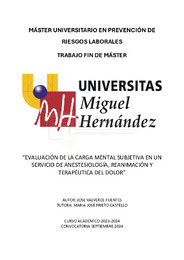Please use this identifier to cite or link to this item:
https://hdl.handle.net/11000/36613Full metadata record
| DC Field | Value | Language |
|---|---|---|
| dc.contributor.advisor | Prieto Castello, María José | - |
| dc.contributor.author | Valverde Fuentes, José | - |
| dc.contributor.other | Departamentos de la UMH::Patología y Cirugía | es_ES |
| dc.date.accessioned | 2025-05-19T09:12:45Z | - |
| dc.date.available | 2025-05-19T09:12:45Z | - |
| dc.date.created | 2024-07-22 | - |
| dc.identifier.uri | https://hdl.handle.net/11000/36613 | - |
| dc.description.abstract | Objetivo: investigar los niveles de carga mental subjetiva en los médicos del Servicio de Anestesiología, Reanimación y Terapéutica del Dolor y determinar si hay diferencias basadas en el sexo, la edad y la antigüedad en el trabajo. Se compararán estos niveles con los de otros trabajadores con características similares, expuestos al mismo ambiente. Finalmente, se propondrán medidas preventivas e intervenciones adecuadas. Material y métodos: se utilizará la Escala Subjetiva de Carga Mental de trabajo (ESCAM) a una muestra de trabajadores de un servicio de Anestesiología para evaluar los condicionantes ambientales en el trabajo y las dimensiones en las que se ve dividida la carga mental de trabajo. Resultados: los resultados obtenidos en cuanto a los condicionantes ambientales del trabajo son aceptables con unas medias parecidas siendo las de mayor conformidad la iluminación y las condiciones higiénicas. Analizando las dimensiones como bloques, se observan diferencias estadísticamente significativas en cuanto a los niveles de carga mental subjetiva con respecto a la edad de los participantes, el nivel de estudios cursados y el tipo de puesto dentro del área quirúrgica. Analizando los ítems de manera individual no se encontraron diferencias estadísticamente significativas en el sexo de los participantes ni en el estado civil, hallándose diferencias en el resto de las variables, siendo los ítems más repetidos aquellos derivados de las dimensiones "características de la tarea", "demandas cognitivas y complejidad de la tarea" y la "temperatura" como "condicionante ambiental del trabajo". Conclusiones: la ESCAM es una herramienta sencilla para evaluar los niveles de carga mental subjetiva, detectar situaciones intolerables y sugerir medidas preventivas e intervenciones adecuadas. | es_ES |
| dc.description.abstract | Purpose: to investigate the levels of subjective mental workload in physicians of the Anesthesiology, Resuscitation and Pain Therapy Service and to determine if there are differences based on sex, age and seniority in the job. These levels will be compared with those of other workers with similar characteristics, exposed to the same environment. Finally, appropriate preventive measures and interventions will be proposed. Material and methods: the Subjective Scale of Mental Workload (ESCAM) will be used on a sample of workers in an anesthesiology department to evaluate the environmental conditioning factors at work and the dimensions into which the mental workload is divided. Results: The results obtained in terms of the environmental conditions of the workplace are acceptable with similar averages, with the lighting and hygienic conditions being those with the highest levels of conformity. Analysing the dimensions as blocks, statistically significant differences were observed in the levels of subjective mental workload with respect to the age of the participants, the level of studies undertaken and the type of post in the surgical area. Analysing the items individually, no statistically significant differences were found in the sex of the participants or in marital status, and differences were found in the rest of the variables, with the most repeated items being those derived from the dimensions ‘characteristics of the task’, ‘cognitive demands and complexity of the task’ and ‘temperature’ as an ‘environmental conditioning factor of the work’. Conclusions: the ESCAM is a simple tool for assessing levels of subjective mental workload, detecting intolerable situations and suggesting appropriate preventive measures and interventions. | es_ES |
| dc.format | application/pdf | es_ES |
| dc.format.extent | 72 | es_ES |
| dc.language.iso | spa | es_ES |
| dc.publisher | Universidad Miguel Hernández | es_ES |
| dc.rights | info:eu-repo/semantics/openAccess | es_ES |
| dc.rights.uri | http://creativecommons.org/licenses/by-nc-nd/4.0/ | * |
| dc.subject | carga mental | es_ES |
| dc.subject | ESCAM | es_ES |
| dc.subject | condiciones ambientales | es_ES |
| dc.subject | Anestesiología | es_ES |
| dc.subject | Enfermería | es_ES |
| dc.subject | Celators | es_ES |
| dc.subject | Nursing assistants | es_ES |
| dc.subject | ergonomics | es_ES |
| dc.subject.other | CDU::6 - Ciencias aplicadas::61 - Medicina::614 - Higiene y salud pública. Contaminación. Prevención de accidentes. Enfermería | es_ES |
| dc.title | Evaluación de la carga mental subjetiva en un servicio de anestesiología, reanimación y terapéutica del dolor. | es_ES |
| dc.type | info:eu-repo/semantics/masterThesis | es_ES |

View/Open:
VALVERDE FUENTES_JOSE _TFM.pdf
2,96 MB
Adobe PDF
Share:
.png)
